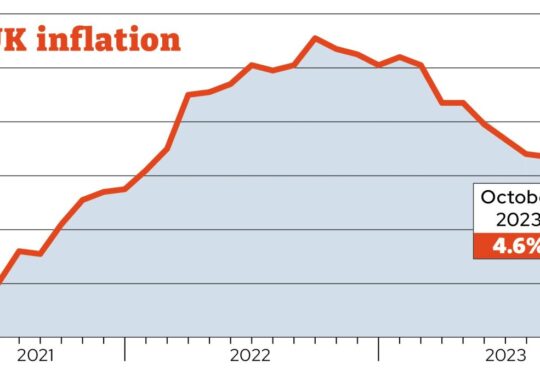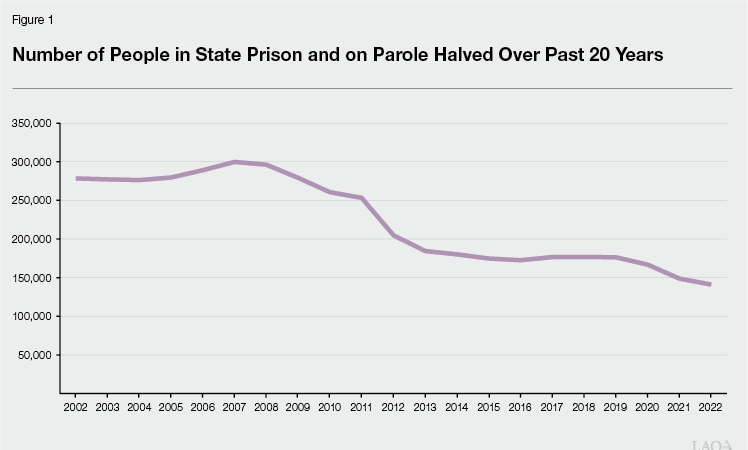
On Saturday, August 26, 2023, the administration released a proposed
labor agreement between the state and Bargaining Unit 6 (Corrections).
Unit 6 consists of correctional officers, parole agents, and other
correctional staff who provide custody, supervision, and treatment of
people in state custody. As of July 3, 2023, Unit 6 members work under
the terms and conditions of an expired memorandum of understanding
(MOU). Compensation costs for Unit 6 members and their managers
constitute about one-third of the state’s General Fund state employee
compensation costs. Unit 6’s current members are represented by the
California Correctional Peace Officers Association (CCPOA). This
analysis of the proposed agreement fulfills our statutory requirement
under Section 19829.5 of the Government Code. The administration has
posted on the California Department of Human Resources’ (CalHR’s)
website the agreement,
a summary
of the agreement, and a summary of the administration’s estimates of the
proposed agreement’s fiscal
effects.
Background
Unit 6 in Context of State
Workforce
Represents 10 Percent of State Workforce.
The monthly average size of the state workforce in 2022 was 252,300
full-time equivalent employees. About 10 percent of these employees were
a member of Unit 6.
Accounts for About One-Third of State General Fund
Payroll Costs. The annualized April 2023 state salary and
salary-driven benefit costs paid from the General Fund was
$17.8 billion. The salary and salary-driven costs for rank-and-file and
affiliated excluded employees for Unit 6 constituted roughly one-third
of these General Fund payroll costs.
Prison Costs
Number of People in Prison and on Parole Has Decreased
but Costs Have Not. As Figure 1 shows, the number of
people in state prison or on parole has decreased significantly over the
past 20 years such that the number of people in state prison or on
parole in 2022 is about one-half the number in 2002. The state
correctional population is projected to continue to decline somewhat
through June 2027. The decline in prison population has allowed the
state to reduce prison capacity without violating a federal
court-ordered limit on prison overcrowding. Specifically, in 2021, the
California Department of Corrections and Rehabilitation (CDCR) completed
a multiyear drawdown of people housed in contractor-operated prisons. In
addition, the department deactivated various state-operated prison
facilities since 2021. Specifically, CDCR deactivated Deuel Vocational
Institution in Tracy in 2021, California Correctional Center in
Susanville in 2023, and eight yards at various prisons between 2021 and
2023. However, despite these declines in the number of people in prison
and the number of facilities used to house them, CDCR spending generally
has increased. Specifically, CDCR operational spending increased from
$11.8 billion in 2017‑18 to an estimated $14.8 billion in 2022‑23—a
25 percent increase. With inflation during this period rising
23 percent, this means that growth in CDCR operational spending slightly
outpaced inflation. The budget assumes that CDCR operational spending
will decrease by $415.8 million in 2023‑24 relative to 2022‑23 levels;
however, this does not reflect any increased costs resulting from new
labor agreements. Employee compensation costs are a major driver in CDCR
operating costs. If the proposed Unit 6 and other agreements are
ratified by the Legislature, costs will be higher than they were in
2022‑23.
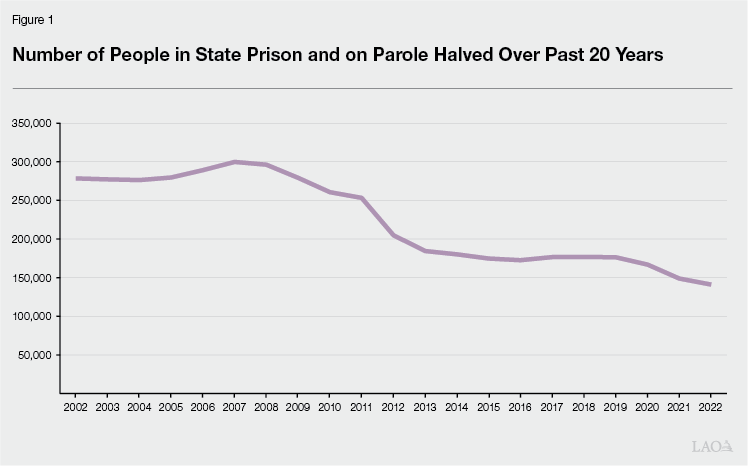
Number of People in Prison and on Parole Has Declined
Faster Than Number of Unit 6 Members. Over the past 20
years, the number of Unit 6 members has decreased as the state has
employed fewer correctional staff. However, the decline in the number of
Unit 6 members has been less than the decline in prison and parole
populations. As Figure 2 shows, while the prison and parole populations
decreased by 50 percent during the period, the number of Unit 6 members
decreased only 15 percent. This trend is, in large part, related to a
federal court order that required California to reduce prison
overcrowding. Specifically, despite the decline in the number of people
in prison, the state had to maintain existing prison capacity, as well
as build and staff new prison capacity, in order to comply with the
limit.
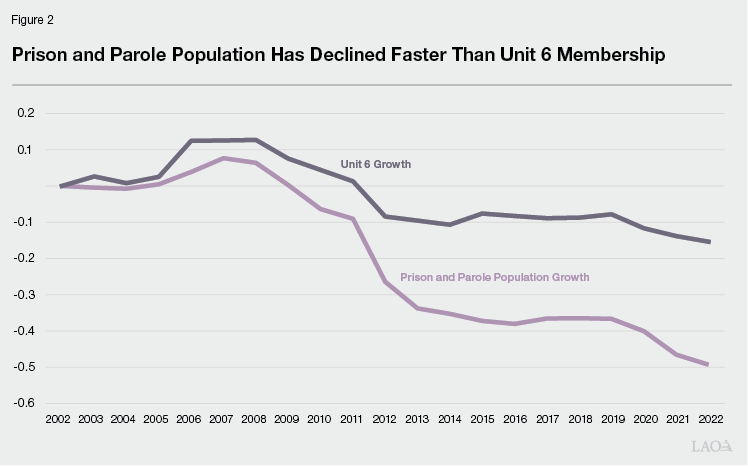
Compensation Studies
Important Tool for Any Employer. A
compensation study aggregates and analyzes internal and external data so
that an employer can compare the compensation structure it offers to
what is provided by similar employers with similar employees in the same
labor market. Employers in both the public and private sectors commonly
conduct regular compensation studies to monitor changes in the labor
market. A well designed and executed compensation study is a valuable
tool that provides a number of benefits, including helping employers
(1) determine if they are compensating employees fairly and at a level
that will attract skilled workers, (2) allocate limited resources
efficiently and effectively by not paying employees more than is
required to retain them, (3) identify internal equity issues regarding
their compensations structure, and (4) establish a structure for their
decision-making process when making changes to their compensations
structure. In addition, for public employers, a compensation study
brings transparency to the decision-making process such that employees,
policymakers, and the public all have the same information against which
to evaluate proposed changes in compensation.
Comparators and Methodology Key to Understanding Purpose
and Usefulness of Compensation Study. Not all compensation
studies are equally relevant or helpful in assessing the issues we
identified above. Factors that affect the quality of a compensation
study include (1) the similarity of jobs that are included in the study
for comparison, (2) the extent to which the elements of compensation
compared capture the total compensation earned by employees, and (3) the
similarity and relevance of employers selected for comparison.
State Law Requires General Salary Increases (GSIs) Be
Justified… A GSI adjusts the entire salary range for a
classification such that all employees within that classification
receive the pay increase. Section
19826 of the Government Code specifies that CalHR shall establish
salary ranges for state classifications “based on the principle that
like salaries shall be paid for comparable duties and responsibilities.”
Further, the law requires that—when establishing or changing pay
ranges—“consideration shall be given to the prevailing rates for
comparable service in other public employment and in private business.”
These requirements necessitate that changes to state salaries be
justified based on comparisons to other comparable employers.
…And Requires CalHR to Conduct Salary
Studies. Since 1981, Section 19826 has required the
administration to submit to the Legislature and bargaining units a
report containing the department’s findings related to salaries of
employees in comparable occupations in private industry and other
governmental agencies. Originally, the law required that this report be
submitted to the Legislature on or before January 10 of each year.
Chapter 465 of 2003 (SB 624, Committee on Public Employment and
Retirement) changed the frequency of this report such that the report
was required to be submitted to the union and the Legislature at least
six months before the end of the term of an existing MOU. Chapter 39 of
2023 (AB 130, Committee on Budget) amended the section such that the law
now requires that CalHR submit to the unions and Legislature a report
containing the department’s findings relating to the salaries of
employees in comparable occupations in private industry and other
governmental agencies (1) on February 1, 2025 and biennially thereafter
for 11 bargaining units and (2) on February 1, 2026 and biennially
thereafter for the remaining ten bargaining units (including Unit 6). If
this requirement under law conflicts with provisions of a ratified MOU,
the law specifies that the ratified MOU shall be controlling.
Annual Budget Act Imposes Additional Requirements of
Total Compensation Studies. As the administration
indicated in its 2013
total compensation study for Unit 6, provisional language under
CalHR’s budget item (Item 7501‑001‑0001) of the annual budget act
“requires that in addition to salaries the report must include total
compensation and geographic comparisons.” In the department’s total
compensation reports for most bargaining units, these requirements are
fulfilled by (1) comparing both salary and ancillary benefits offered by
the state and comparator employers and (2) evaluating how the state’s
total compensation compares with other employers statewide as well as in
four regions across the state (specifically, the regions surrounding the
San Francisco Bay, Sacramento, Los Angeles, and San Diego).
Evaluating
State Correctional Officer Compensation
State Law Requires Administration to Take Into
Consideration Compensation Offered by Other Large Employers of Peace
Officers in California. Section
19827.1 consists of two paragraphs. The first paragraph expresses
legislative intent. Specifically, the first paragraph asserts that, at
the time the law was passed in 1986, (1) there existed a “historic
problem of recruitment and retention of peace officers in the Department
of Corrections and the Department of Youth Authority” and that (2)
“salaries must be improved and maintained by the state” to address the
“continuing need to recruit new officers to fill vacancies, retain
seasoned correctional peace officers to reduce turnover rates, and
provide comparability in pay to effectively compete with large peace
officer employers and ensure necessary staffing levels.” The second
paragraph directs CalHR to “take into consideration the salary and
benefits of other large employers of peace officers in California.”
Last Unit 6 Total Compensation Study Found State
Correctional Officers Compensated High Above Market. The
last Unit 6 compensation
study that CalHR submitted to the Legislature in compliance with the
requirements under Section 19826 used data from 2013. That compensation
study found that state correctional officers were compensation
40.2 percent above their local government counterparts and
28.1 percent above their federal government counterparts.
Expired MOU Requires CalHR to Discuss Section
19826 Compensation Study Methodology With Union. First
appearing in the 2016 Unit 6 MOU, the expired Unit 6 MOU includes
language related to the compensation study required by Section 19826.
The expired MOU’s provision is Article 15.19 and requires that:
Within ninety (90) days of ratification of this MOU, the parties
agree to form a Joint Labor Management group who will meet to discuss
the criteria, comparators and methodology to be utilized for [Bargaining
Unit] 6 in the next Total Compensation Report created pursuant to
Government Code section 19826. The Joint Labor Management group will be
comprised of no more than two (2) representatives from each of the
following: CCPOA, CalHR, CDCR and Department of Finance. The first
meeting of the Joint Labor Management group will occur no later than
eighteen (18) months prior to the expiration of the MOU.
It is important to note that the text of Article 15.19 (1) does
not relieve CalHR of the requirements established by Section 19826
and the annual budget act related to the total compensation study
produced by CalHR—including that the report be submitted to
both the Legislature and the union, (2) does not make
any reference to Section 19827.1, and (3) specifies that any discussion
between the administration and the union related to the compensation
study will occur before CalHR begins its compensation
study.
No Compensation Study Provided to the Legislature in
2018. Despite the statutory requirements to submit a
compensation study to the Legislature prior to the expiration of the
2016 MOU, none was provided. The administration states that it met with
Unit 6 as provided under Article 15.19 described above and that CalHR
completed a compensation study based on the methodology agreed to by
CCPOA and the administration. Although the administration provided the
compensation study to CCPOA in 2018, the Legislature did not receive it.
CalHR stated that it had agreed not to submit to the Legislature the
compensation study until all of CCPOA’s questions and concerns had been
addressed.
Since 2019, our office has asked on numerous occasions for the
administration to provide us a copy of the 2018 compensation study or to
provide us information about the methodology used in that study. To
date, the administration has refused to provide the study itself or to
share any information about the study’s methodology or findings. The
administration asserts that the 2018 compensation study and all
information related to it is confidential pursuant to Section
7928.405 of the Government Code—a section from the California Public
Records Act (CPRA). The administration states that this law classifies
as confidential any work, including draft reports, from a Joint Labor
Management Committee (JLMC). The administration views the 2018
compensation study as a draft product of a JLMC process. Accordingly,
the administration’s position means the Legislature is not privy to the
draft report or any information or documentation related to it.
2022 Unit 6 CalHR Compensation
Study
Study Submitted After Statutory Deadline.
The term of the expired MOU ended on July 2, 2023. As discussed above,
Section 19826 of the Government Code before Chapter 39 amended it in
July 2023, required CalHR to submit its total compensation study for a
bargaining unit six months before the expiration of the bargaining
unit’s MOU. To comply with state law at the time, CalHR should have
submitted a Unit 6 compensation study to CCPOA and the Legislature by
January 2023. While we do not know when CalHR submitted the study to
CCPOA, the department did not meet its statutory deadline. The study was
submitted to the Legislature in April 2023. This study was revised in
August 2023.
Methodology and Report Product of JLMC
Process. Pursuant to Article 15.19 of the expired MOU, the
parties discussed the methodology to be used to develop a new Unit 6
compensation study. Because the administration has not provided any
information about the 2018 compensation study, we do not know how the
methodology or findings of the 2022 compensation study differs from the
methodology or findings of the 2018 methodology. We also do not know how
the issues that prevented the 2018 compensation study from being
submitted to the Legislature were resolved to result in the release of
the 2022 study.
Study Design and Findings
Stated Intent of Report. The report
specifies that the findings of the report do not define the appropriate
level of compensation for state correctional officers. Instead, the
stated purpose is to compare the state’s total compensation costs with
other local government employers in California.
Employers Surveyed. The report compares
employer costs to pay for elements of compensation provided to state
correctional officers with the costs incurred by six county employers to
compensate similar employees. The six counties included in the study are
the six counties that employ the largest number of peace officers.
Specifically, the study compares the state’s compensation costs with the
costs incurred by the Counties of Los Angeles, Orange, Santa Clara,
Sacramento, San Bernardino, and San Diego.
Classifications Compared. The survey asked
each county employer to report compensation costs related to specific
classifications. Figure 3 shows the classifications that were used for
comparison.
Figure 3
Employers and Classifications
Compared in 2023 Unit 6 Compensation Study
|
Employer
|
Classification Title
|
|
State of California
|
Correctional Officer
|
|
Los Angeles County Sheriff’s Department
|
Deputy Sheriff
|
|
Orange County Sheriff’s Department
|
Deputy Sheriff I
|
|
Santa Clara County Sheriff’s Department
|
Sheriff Correctional Deputy
|
|
Sacramento County Sheriff’s Department
|
Deputy Sheriff
|
|
San Bernardino County Sheriff’s Department
|
Deputy Sheriff
|
|
San Diego County Sheriff’s Department
|
Deputy Sheriff, Detentions/Court Services
|
Elements of Compensation Included. CalHR
surveyed the six counties to provide employer compensation cost data as
of January 31, 2022 for the classifications indicated above. The report
seeks to compare separately the compensation cost of entry-level
correctional officers with entry-level deputy sheriffs (after graduating
from the academy) and full journey-level correctional officers with full
journey-level deputy sheriffs. This distinction is important because
employees who have worked for the state or for one of the counties for a
significant number of years have higher compensation than new officers
who recently graduated from the academy. Newly hired employees typically
(1) are in a lower step of the classification pay range (earning lower
base salaries), which results in lower employer costs to salaries and
any salary-driven benefits; (2) are not eligible for payments that are
based on length of service until they have worked for at least a
specified time; (3) typically are not eligible for payments based on
special certifications or training as they have less experience than
more senior employees; and (4) were first hired after 2013, meaning that
they likely receive a lower pension benefit pursuant to state
law. Below are the elements of compensation included in the
study.
-
Pay. The report includes base wages and
specified other payments to employees included as compensation. For base
pay, the report assumes that entry-level employees are paid at the
bottom step of their classification’s salary range and journey-level
employees are assumed to be paid at the top step of their
classification’s salary range. For the other payments included in the
study—education pay, payments provided for certifications attained by
employees from the California Commission on Peace Officer Standards and
Training, and payments received by employees who have worked for the
employer for more years—the study assumes that entry-level employees
receive the lowest available payment and journey-level employees receive
the highest available payment. -
Health, Dental, and Vision Benefits.
The report assumes that both entry-level and journey-level employees are
enrolled in employer-sponsored health, dental, and vision insurance with
policy coverage for a family. -
Retirement Benefits. As we discuss in
greater detail later, the study includes employers’ costs towards
pension benefits and retiree health benefits.
Methodology. CalHR developed and
distributed a survey to the six county employers to collect the employer
costs to provide the specified elements of compensation. CalHR then took
a simple average of the employer costs across the six employers to
compare total compensation costs of the six employers with that of the
state.
Findings. Based on the comparators and
methodology used in the study, CalHR found that state correctional
officer compensation lags the compensation provided to similar employees
by the six counties. This means that CalHR found that state correctional
officers are compensated less than similar employees in the six
counties. Specifically, the study (as revised) found that (1) the
state’s salaries (not including benefits) lag 28 percent for
entry-level employees and 10 percent for full journey-level employees
and (2) the states’ total compensation (salary plus benefits)
lags 33 percent for entry-level employees and 23 percent for
full journey-level employees.
Retirement Security
Factors That Affect Retirement Security.
The amount of money that a person can expect to need in retirement
depends on a variety of factors that are unique to the individual’s
circumstance. Some of the key factors to consider when assessing
retirement security include: the individual’s expected lifespan, the age
at which an individual retires. the standard of living the individual
expects to live in retirement, the individual’s savings level upon
retirement, and any employer-sponsored pension or other income benefit.
A person’s level of retirement security depends in part on how much of
their pre-retirement income can be replaced after retiring through a
combination of what often is referred to as the “three-legged stool” of
retirement in the United States: (1) Social Security benefits,
(2) employer-sponsored retirement plans, and (3) personal financial
assets. There is no one-size fits all replacement ratio; however, a
number of researchers have identified that the replacement ratio for the
median individual is between 66 percent and 75 percent of preretirement
income. In general, lower-income workers would need a higher replacement
ratio because they would be expected to spend a higher proportion of
their income on food, clothing, housing, transportation, health care,
and other essentials.
Employer-Sponsored Retirement Plans. There
are two broad categories of employer-sponsored retirement plans: defined
benefit plans and defined contribution plans. In both types of plans,
employers and employees might make contributions towards the plan over
the course of employees’ careers. The primary difference between the two
plans is (1) who makes investment decisions and (2) who bears the risk
of investment losses. In the case of a defined benefit plan, the
employer chooses how the funds are invested and bears all the risk of
investment loss—the employee is provided a guaranteed annuity in
retirement. In the case of a defined contribution plan, the employee
chooses how contributions are invested and bears all the risk of
investment losses. Unlike a defined benefit plan, there is no
guarantee—either by the employer or by government—of assets held in a
defined contribution plan.
Hybrid Employer-Sponsored Retirement Plans.
Some employers offer employees a hybrid plan that combines elements of
traditional defined contribution and defined benefit plans. For example,
a parallel hybrid plan provides employees both an employer-funded
defined benefit pension and an employer-funded defined contribution
plan. Typically, the defined benefit and defined contribution components
of these types of plans are smaller than if the employer offered only a
defined benefit or only a defined contribution plan. The amount of money
that the employer contributes to each plan typically is based on an
employee’s total pay.
Correctional
Officer Retirement Income Benefits
Not Eligible for Social Security. When
Social Security was initially established in 1935, all federal, state,
and local government employees were excluded from the program. Beginning
in the 1950s, the program was changed to allow governments to enroll
some of their employees in the federal program. By 1991, the program
covered all federal employees and most state and local government
employees. Under federal law, state and local government employers may
continue to exclude some employees from Social Security coverage, but
only if those employees are enrolled in a retirement plan that meets
federal regulations requiring at least a specified level of benefits. In
California, peace officers and teachers generally are excluded from
Social Security.
Defined Benefit Pensions a Long-Standing and Significant
Element of Compensation in California State Employment.
The state has included in its compensation package a defined benefit
pension since 1932. The benefit, as it exists today, provides retired
state employees a guaranteed annuity that is determined by (1) the
employee’s date of hire, (2) the number of years of service the employee
has upon retirement, and (3) the employee’s age at retirement. These
benefits are paid for through contributions towards two components of
the benefit’s cost, discussed below.
-
Normal Cost. The normal cost is the
amount of money that actuaries determine must be set aside for the
benefit employees earn today so that the contribution and any
future investment returns on that contribution are sufficient to pay for
the benefit after the employee retires. Under the Public Employees’
Pension Reform Act of 2013 (PEPRA), the state has a standard that state
employees pay one-half of the normal cost of their pension benefit and
the state pays one-half of the normal cost. -
Unfunded Liability. When investment
returns or other actuarial assumptions do not materialize (or actuarial
assumptions change) such that actuaries determine there are not
sufficient assets to pay for benefits earned in the past, the
resulting shortfall is called the “unfunded liability.” Any unfunded
liability is the employer’s responsibility.
Unit 6 Employees Hired Before 2013 Receive Pension Based
on “3 Percent at 50” Formula. The pension benefits earned
by state public safety employees—including Unit 6 members who earn their
pension benefit under the state’s Peace Officers and Firefighters
plan—are described in this publication
produced by the California Public Employees’ Retirement System
(CalPERS). Unit 6 members hired before 2013 earn a pension benefit based
on what is referred to as the 3 percent at 50 formula whereby an
employee earns 3 percent of their final compensation for every year of
service if they retire at the age of 50 years. Under this formula, the
maximum income replacement ratio a retiree may receive is 90 percent of
their final compensation (defined as compensation over a 12-month
period) after attaining 30 years of service credit. According to
information provided by CalHR, in the five fiscal years between 2017‑18
and 2021‑22, the average Unit 6 member retired at 55 years old with 23
years of service and retired with a pension that replaced 68 percent of
their final compensation.
Unit 6 Employees Hired After 2013 Receive Pension Based
on “2.5 Percent at 57” Formula. Under PEPRA, employees
hired after 2013 receive a lower pension benefit that require employees
to work additional years in order to maintain the same level of benefit
as employees who were hired before 2013. In the case of Unit 6,
employees hired after 2013 earn a pension under the 2.5 percent at 57
formula. Under this formula, employees who work for 40 years and are
older than 57 years may receive a pension that replaces 100 percent of
their final compensation (defined as compensation over a 36-month
period). However, an employee under this pension formula who retires at
55 years old with 23 years of service would be eligible for a pension
that replaces 54 percent of their final compensation. In order to
receive the 68 percent income replacement ratio received by average
recent Unit 6 retiree, a Unit 6 member hired after 2013 would need to
work until they are at least 57 years old and have 27 years of
service.
Optional Employee-Funded Defined Contribution
Benefit. Since 1974, the state has provided employees with
an optional deferred compensation plan. The plan today is known as
Savings Plus. Through Savings Plus, employees can open a 401(k) and/or a
457(b) account and can choose to make contributions on a pre-tax or
post-tax basis to these accounts. Employees can then choose from a
variety of investment options, including indexed and managed funds and
target-date funds. The state has never made regular contributions to
rank-and-file employees’ Savings Plus accounts. (CalHR informs us that
the state briefly contributed a small specified dollar amount to
excluded employees’ Savings Plus accounts in the early 2000s.) In 2017,
we issued a report evaluating
the Savings Plus program. As of May 2016, we reported that 60 percent of
eligible state employees participated in the Savings Plus program. While
we do not know the statewide average participation rate today, CalHR
informs us that, as of July 31, 2023, 87 percent of Unit 6 members have
a Savings Plus account and that 57 percent of Unit 6 members contributed
to their Savings Plus account in July 2023 with an average contribution
amount of $387 to a 457(b) account and $353 to a 401(k) account. Based
on the data CalHR provided us, far more Unit 6 members have 457(b)
accounts (20,241 members with accounts) than 401(k) accounts (4,599
members with accounts). The administration indicates that the average
balances of Unit 6 457(b) and 401(k) accounts was $20,803 and $27,272,
respectively.
Legislature Chose Not to Adopt Hybrid Plan When Enacting
PEPRA. Under PEPRA, the Legislature established sweeping
changes to state pension benefits that reduced the benefits for future
employees and established a standard that state employees pay one-half
of the normal cost to fund these benefits. However, the law retained the
basic structure of the state’s benefit in that the employer-funded
retirement income benefit consists only of a defined benefit pension.
The Legislature could have adopted a hybrid plan, whereby the state
contributed money to both a defined benefit and a defined contribution
element of a retirement benefit, but it did not.
Proposed Agreement
Major Provisions
Term. The agreement would be in effect from
July 3, 2023 through July 2, 2025. This means that the agreement would
be in effect for two fiscal years: 2023‑24 and 2024‑25. This also means
that the agreement will expire, and the administration presumably will
begin negotiating a new MOU, before the February 1, 2026 date
when Section 19826 of the Government Code requires CalHR to submit to
the Legislature a new compensation study for Unit 6.
GSIs. The agreement would provide a
3 percent GSI on July 1, 2023 and another 3 percent GSI on July 1,
2024.
One-Time $1,200 Payments in 2023 and Again in
2024. The agreement would provide employees a $1,200
payment in November 2023 and another $1,200 payment in November 2024.
The stated purpose of this payment is to support employees’ health and
well-being. However, there is no requirement that the money be used to
further this purpose.
Recruitment and Retention Payments. The
agreement would provide specified payments related to recruiting and
retaining employees. Specifically, new and current Unit 6 members who
work at Salinas Valley State Prison (SVSP) in Soledad; California State
Prison, Sacramento (SAC); or Richard J. Donovan (RJD) Correctional
Facility in San Diego would be eligible to receive $5,000 payment on
July 1, 2024 and another $5,000 payment on July 1, 2025. In addition,
cadets who accept or choose to work at one of 13 facilities would be
eligible to receive a $5,000 bonus payment payable in two payments
($2,500 upon graduating from the academy and $2,500 30 days after
reporting to the institution).
Creation of Employer Funded Contributions to
401(k). Effective with the November 2024 pay period, the
agreement would provide that the state make a one-time contribution of
$475 to a Savings Plus 401(k) plan on behalf of all permanent full-time
employees who are active as of November 1, 2024. Effective with the
January 2025 period, the agreement would require the state to make a
monthly contribution equivalent to 1 percent of base pay to a Savings
Plus 401(k) plan.
State Contributions to Health Premiums. The
agreement would increase state contributions towards employee health
benefits to maintain the current proportion of average premiums paid by
the state.
Increased Pay Differentials. The agreement
would increase various Unit 6 pay differentials, including the
night/evening shift differential, weekend shift differential, and
bilingual pay differential.
One-Time Leave Cash Out. Under the proposed
agreement, all Unit 6 member would be eligible to cash out up to 80
hours of compensable leave in 2023. The administration estimates that
this provision could increase state costs by as much as $25 million. The
actual cost will depend on how many employees cash out leave and how
much leave they choose to cash out.
Provisions From
Past Agreements Not Included
No Reopener if Other Units Get Higher Pay
Increases. The expired Unit 6 MOU included a provision
that specified that CCPOA could choose to reopen that agreement if
another bargaining were to have received a higher GSI in 2022‑23. As we
discussed in our August 2022 analysis of the Unit 2 agreement
at the time, that particular reopener clause seemed to affect the
administration’s negotiating position with other bargaining units in
that none of the agreements provided GSIs higher than the Unit 6 GSI in
2022‑23. The proposed agreement does not appear to includes a
similar reopener clause.
No Provision Related to Compensation Study.
The proposed agreement deletes Article 15.19 from the agreement. This
means that the proposed agreement includes no language related to the
Unit 6 compensation study or to Section 19286 of the Government Code.
The administration states that it will use the same methodology in
future Unit 6 compensations studies that it used for the 2022
compensations study.
LAO Assessment
2018 Compensation Study
Disagree That 2018 Compensation Study Is Confidential
Under CPRA. We disagree with the administration’s
assertion that the 2018 compensation study and all information related
to it are confidential under the CPRA. The language of Article 15.19
clearly stated that the JLMC process would occur before CalHR
conducted its compensations study when it said that the parties would
discuss the criteria, comparators, and methodology to be
utilized. Further, Article 15.19 states that the compensation study
completed after the JLMC process would be “created pursuant to
Government Code Section 19826.” Under Section 19826 of the Government
Code, CalHR is the sole author of the compensation study as the study is
to report to the union and Legislature “the department’s
findings.” We would argue that the language of Article 15.19 does not
make the compensation study itself a product of the JLMC process—only
the discussion of the methodology. As such, when CalHR submitted the
compensation study to CCPOA it also should have submitted it to the
Legislature.
CPRA Issue Raises Broader Questions About JLMC Work and
Legislative Deliberation. Most, if not all, MOUs include
at least one JLMC or similar management/labor workgroup. These
workgroups can be tasked with discussing a wide array of topics. Often,
the topics of these workgroups are meant to be the initial assessment of
whether something is feasible. For example, an MOU might establish a
JLMC to assess the feasibility of consolidating classifications. In
these cases, the working group often submits a report to specified
individuals (typically, the Director of CalHR) with the group’s
recommendations, but the actual process of consolidating classifications
is left to the State Personnel Board process and the Legislature’s
budget review process (in the case of class consolidations that require
appropriations). In these cases, there is an opportunity for the public
and the Legislature to weigh in on the issue under consideration by the
JLMC. However, as the 2018 compensation study reveals, there also are
instances where the JLMC may influence state policy without legislative
insight. This is because the JLMC process generally is excluded from
public disclosure under the CPRA. Consequently, unless there is a
separate policymaking process—like in the example regarding
classification consolidation—the administration may propose policy
changes without sufficient justification. As the administration does not
offer justifications for things that are the product of the bargaining
table, neither the Legislature nor the public may have sufficient
information to weigh the rationale for the proposed policy change.
2022 Unit 6 Compensation Study
Study Flawed
As we discuss below, the study is flawed to the point that it is not
helpful in meeting its stated objective and we recommend policymakers
not use it to assess whether the state’s compensation package for
correctional officers is appropriate to attract and retain qualified
workers. On the whole, the issues we discuss below likely result in
overstating competitor employer’s total compensation while understating
the state’s total compensation; however, the flaws in the study raise so
much uncertainty that we cannot say that definitively.
Issues With
Comparators and Survey Sample
Study Omits Overtime, a Substantial Component of
Compensation. Overtime has long constituted a significant
source of income for Unit 6 members. CalHR’s 2013 Unit 6 compensation
study included overtime in its analysis and identified that the average
Unit 6 member earned overtime pay equivalent to 15 percent of their
wages. Overtime continues to be a major source of income for state
correctional officers. In 2022, Unit 6 members earned $547.8 million in
overtime payments and $2.2 billion in gross regular pay. This means that
overtime payments in 2022 were equivalent to roughly 24 percent of gross
regular pay for Unit 6 members. Overtime was excluded from CalHR’s 2022
compensation study analysis despite (1) overtime consistently being a
major component of Unit 6 compensation and (2) CalHR including overtime
in its 2013 Unit 6 compensation study and in its recent compensation
studies of most other bargaining units.
Survey Sample Not Representative of Where State
Correctional Officers Work… The compensation study
surveyed the six counties that employ the most peace officers in the
state. This methodology results in a sample consisting mostly of
counties that are part of large metropolitan regions in the state. In
contrast, most state prisons are located in rural parts of the state
located far from major urban centers. As a result, the six counties
surveyed for the compensation study are not representative of
where state correctional officers work. While some state correctional
officers work in four of the counties included in the survey, there are
zero state correctional officers who work in the Counties of
Orange or Santa Clara. Thus, one-third of the compensation comparison in
the study is not actually directly competing with the state for
workers.
As Figure 4 shows, only 18 percent of Unit 6 members work in one of
the six counties included in the survey. If, instead, the survey was
based on the six counties where the most Unit 6 members work—the
Counties of Kern, Kings, Riverside, Solano, Monterey, and Sacramento—the
study would have included counties where more than 50 percent of Unit 6
members work. (If the survey only included the two counties where the
highest numbers of Unit 6 members work, the Counties of Kern and Kings,
the sample would have been more representative than the sample used by
the administration as more than 25 percent of Unit 6 members work in one
of those two counties.)
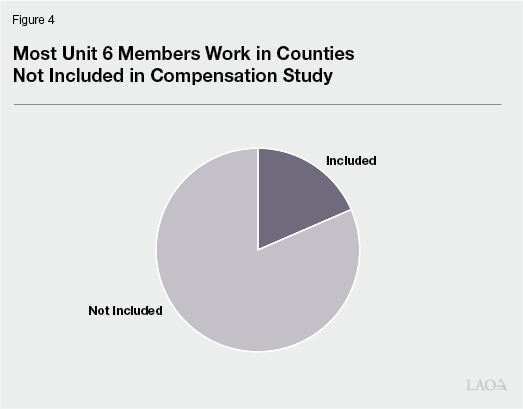
…Reflects Regions With Much Higher Wages and Cost of
Living Than Where Correctional Officers Work. Wages and
the cost of living vary significantly across the state. As Figure 5
shows, the six counties in the study have average wages that are
somewhat higher than the statewide average and far above
average wages in the six counties with the highest concentration of Unit
6 worksites (the Counties of Kern, Kings, Riverside, Solano, Monterey,
and Sacramento). This means that the study includes counties in the
state with substantially higher wages than where most state correctional
officers work. Furthermore, as Figure 6 shows, the six counties in the
study have far higher housing costs (a major component of the cost of
living) than the six counties with the highest concentration of Unit 6
worksites.
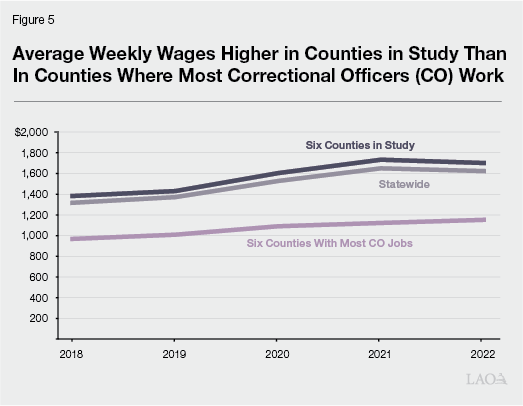
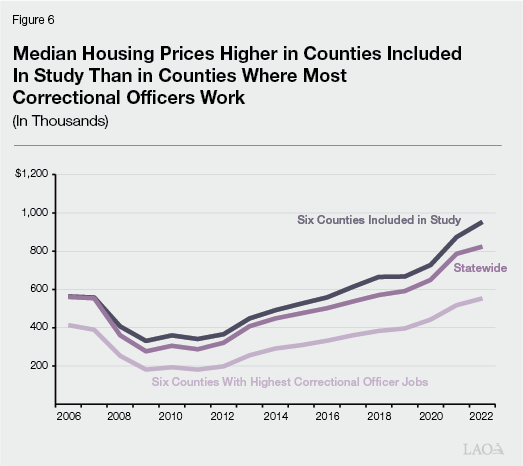
Issues With
Treatment of Retirement Benefits
Study Uses Wrong Measure to Compare Pension
Benefits. Using the total employer contribution rate
towards pension benefits is problematic when trying to evaluate the
value of the pension benefit earned by employees today. This is because
the total contribution rate paid by employers (1) might include a single
blended contribution rate towards normal cost and not distinguish
between the value of benefits earned by different employees in the same
classification, as is the case with at least the state; (2) includes
payments towards unfunded liabilities that reflect costs associated with
pension benefits earned in the past and that are affected by
decisions made by employers (for example, making supplemental pension
payments) or pension boards (for example, assumed rates of return on
investments not be realized) that are not related to the benefit earned
by employees today; and (3) does not capture any employer cost to the
benefit that is excluded from the contribution rate (for example,
supplemental pension payments in excess of the contribution rate). The
normal cost is driven by (1) the design of the pension benefit (in other
words, the terms of the benefit) and (2) the actuarial assumptions used
to calculate normal cost. While different pension systems might use
different assumptions—for example, different assumptions related to
future investment returns—that affect the normal cost, they also have
different policies—for example, different mixes of asset classes in
their investment portfolios. A pension board has a fiduciary
responsibility to use actuarially sound assumptions consistent with its
policies when determining employer contribution rates. As such, the
normal cost for the benefit earned by employees is the best estimate of
the value of the employer-provided benefits earned today by
employees and therefore the best way to compare pension benefits across
employers. We discuss the specifics of the methodological issues related
to pension benefits in the subsequent paragraphs.
Study Includes Employer Payments Towards Unfunded
Liabilities to Value Pension Benefits… As we discussed
above, employers and employees each make contributions towards the
normal cost of a pension benefit. However, the unfunded liability is the
employer’s responsibility. In addition to experience (for example,
lower-than-assumed investment returns) and assumption changes,
employers’ actions also can increase or decrease unfunded liabilities.
For example, an employer choosing to make supplemental pension
payments—meaning they pay more than actuaries say is necessary—will
directly reduce their unfunded liability with no effect on the benefit
provided to employees. When conducting compensation studies, including
the 2022 Unit 6 study, it is CalHR’s practice to include the
total employer contribution rate (expressed as a percentage of
pay) paid by employers to fund employees’ pension benefits. This total
contribution rate includes employers’ costs to both the normal cost and
unfunded liabilities when determining the value of employees’ pension
benefits. This means that the study reflects the cost both for pension
benefits earned today as well as for pension benefits earned in
the past.
…Assumes Same Employer Contribution Rate for Entry-Level
and Journey-Level State Correctional Officers Despite Very Different
Benefits… Under PEPRA, as we discussed above, state
correctional officers hired after 2013 receive a lower benefit than
employees hired before that date. To make state payroll less
complicated, CalPERS provides the state one employer contribution rate
that the state pays, regardless of which benefit an employee earns, that
is based on a blended normal cost. The compensation study uses this
blended employer rate to value the pension benefits earned by newer
state hires and journey-level state correctional officers. As such, the
study assumes that the value of both pension benefits is equivalent to
32.84 percent of pay (19.14 percent of this is the employer’s share of
the blended normal cost). This results in the study undervaluing the
benefit earned by journey-level state correctional officers and
overvaluing the benefit earned by entry-level employees. If the study
had, instead, used the unblended employer share of normal
cost to value the pension benefits earned by state correctional
officers, the study would have assumed that entry level state
correctional officer pension benefits were equivalent to 15.1 percent of
pay and journey-level state correctional officer pension benefits were
equivalent to 22.1 percent of pay. (We note that the study also assumes
that the County of Santa Clara pays the same contribution rate for both
entry-level and journey-level employees.)
…And Uses Data From Year When State Contributions to
Unfunded Liability Was Temporarily Low, Distorting State’s Pension
Benefit to Appear Less Valuable Overall. In recent years,
the state has made a number of supplemental pension payments to CalPERS.
These payments are in addition to the payments CalPERS identifies the
state must pay pursuant to state law and go directly towards paying down
the state’s unfunded liability. (In addition, it is the state’s policy
to apply the Proposition 2 debt
repayments towards the CalPERS unfunded liabilities.) As we describe
in The 2020‑21
Spending Plan: Pensions, the 2019‑20 budget plan included a
$2.5 billion supplemental pension payment to CalPERS to reduce the
state’s long-term unfunded liabilities; however, the 2020‑21 budget
repurposed this supplemental pension payment to instead
supplant the state’s actuarially required contributions over a
multiyear period beginning in 2020‑21 (due to anticipated budget
shortfalls). This action resulted in the portion of the state’s
contribution rate that goes towards the unfunded liability to be lower
than it otherwise would have been in 2021‑22, the year from which data
was pulled for the compensation study. To illustrate the temporary
effect this had on the state’s contribution rates, this action resulted
in the state’s contributions to Unit 6 members’ pensions to total
32.84 percent of pay in 2021‑22, but the rate is 50 percent of pay in
2023‑24 (after the supplanting payment ended).
Study Treats Retirement Health and Retirement Pension
Benefits Inconsistently. The state pays for retiree health
benefits differently from how it pays for pension benefits. In the case
of retiree health benefits, the state pays a percentage of pay towards
normal cost (specified in labor agreements and matched by employees) to
prefund the benefit and it pays the unfunded liability on a
“pay-as-you-go” basis where it pays out the claims cost for existing
retirees. (The state has a significant unfunded liability associated
with retiree health benefits. The most recent valuation
of the benefit estimates the portion of the unfunded liability
associated with Unit 6 to be about $10 billion.) Unlike its treatment of
pensions, the compensation study does not include any portion of the
state’s payments towards retiree health unfunded liabilities. As we
indicated above, we think it is better practice to only include the
normal cost when trying to value a retirement benefit; however, a
compensation study also should be consistent. Had the compensation study
been consistent with how it valued retirement benefits, it would have
included both the state’s contribution to Unit 6 normal cost
($136 million) and the state’s payments towards Unit 6 retirees’ claims
($471 million) that constitute the state’s payments towards the unfunded
liability.
Study Does Not Accurately Reflect Value of Retiree Health
Benefits Provided by County Employers. The study indicates
that all of the surveyed jurisdictions offer an employer-subsidized
retiree health benefit or some form of a retiree health savings or
reimbursement account. However, to establish a value for the benefit,
CalHR only asked the employers if employers made prefunding
contributions towards the benefit. The state only recently began
prefunding retiree health benefits. Many local governments still do not
prefund the benefit and, instead, make payments on a pay-as-you-go basis
after an employee retires. Of the six counties included in the survey,
only two indicated that they make contributions towards the benefit
during employees’ careers (the Counties of Sacramento and San
Bernardino). Accordingly, the study does not attribute any value to
retiree health benefits and undervalues the total compensation earned by
employees of the Counties of Los Angeles, Orange, Santa Clara, and San
Diego.
Study Does Not Accurately Reflect Value of State Retiree
Health Benefit. Following the 2015‑16
budget, the state established lower retiree health benefits for all
future state employees in MOUs. For Unit 6, the arrangement was
established in the MOU that was
ratified in 2016, reducing the benefit for employees hired after 2017.
Per the Unit 6 MOU, the state and all Unit 6 members each pay 4 percent
of pay to prefund the benefit, which is roughly one-half of the total
normal cost for the benefit earned by employees hired before 2017. The
compensation study uses the state’s 4 percent of pay contribution for
both entry-level and journey-level employees, ascribing the same value
to the retiree health benefit to all Unit 6 members. The state’s
actuarial valuation of retiree health benefits calculates the
total normal cost of the benefit for each bargaining unit. The
valuation does not provide separate normal costs for the benefit for
employee hired before 2017 versus those hired after 2017;
however, the normal cost for the benefit earned by new employees
certainly is lower than the normal cost for the benefit earned by
employees hired before 2017. Accordingly, the compensation study
overvalues the retiree health benefit earned by entry-level state
employees and undervalues the retiree health benefit earned by
journey-level state employees.
Overall, Reliance on Employer Cost to Estimate Value of
Benefit Distorts Findings. While comparing employers’
costs to provide compensation to employees makes the survey easier to
administer and complete, the comparisons can be inaccurate, particularly
in the case of retirement benefits. In addition, this methodology also
ignores any deductions that might be made from employees’ pay—reducing
their salaries—to support the benefits provided to them as part of their
total compensation. For example, the study does not capture the effect
on employees’ pay when they are required to contribute a portion of
their salary to prefund a retirement benefit. Employee contributions
towards benefits directly reduce their pay. If two employees have
identical compensation packages except one is required to contribute
4 percent of pay to prefund retiree health benefits while another does
not, that contribution requirement lowers the employee’s pay, resulting
in the employee who is required to contribute towards the benefits
receiving a lower total compensation than the other employee. To
accurately assess the relative attractiveness of employers’ supplied
compensation packages to workers in the labor market, a study should sum
the total pay (including overtime, scheduled pay differentials, or other
payments in addition to base pay), total insurance premiums (health,
dental, and vision), and total normal cost of retirement benefits
(pension and retiree health) and subtract from that the deductions from
pay that employees make towards premiums and normal cost of retirement
benefits.
Study Not Helpful
For the reasons described above, we find that CalHR’s 2022 Unit 6
compensation study is not helpful in assessing how the state’s total
compensation for state correctional officers compares with the six
counties included in the study. Further, because the six counties
included in the study are not representative of where state correctional
officers work and, instead, includes among the highest cost of living
regions of the state, we conclude that the study is not helpful in
assessing the state’s position as an employer of correctional officers
across the state or where state correctional officers work. We recommend
the 2022 study not be used to evaluate whether or not the
state’s compensation for correctional officers is competitive.
Legislative Oversight
Legislative Oversight of State Compensation Policies Key
to Effective Oversight of State Spending. State employee
compensation is a significant portion of the cost of state government
operations, totaling more than $30 billion (roughly one-half of which is
paid from the General Fund). In addition, the state has significant
unfunded liabilities associated with retirement benefits for state
employees’ and retirees’ past service (in excess of $70 billion for
pensions and $95 billion for retiree health benefits). Changes in
employee compensation policies can have profound effects on the state’s
expenditures and long-term plans to address unfunded liabilities. As
such, the Legislature’s ability to exercise a high degree of oversight
over the state’s employee compensation policies is critical.
Compensation Studies Helpful Tool to Evaluate Proposed
Compensation Policies. The Legislature regularly considers
changes to state employee compensation policies through the policy bill
process, the budget bill process, and through its role in considering
labor agreements reached between the administration and state bargaining
units. A regularly occurring, well-designed, and well-executed
compensation study helps provide the Legislature a baseline from which
to assess (1) the state’s current position as an employer in the labor
market and (2) the effect that any proposed employee compensation policy
might have on the state’s position as an employer.
Regular Total Compensation Studies Should Not Be Subject
of Bargaining Process. A compensations study should
present a set of facts identified using a transparent methodology that
can serve as a starting point in negotiations. A compensation study,
itself, should not be the subject of negotiations. If a bargaining unit
disagrees with the methodology or findings of a CalHR compensation
study, it can pay for its own compensation study to be conducted by a
third party. (We note that Unit 2 [Attorneys] contracted with the
University of California at Los Angeles to conduct a study leading up to
the 2019 MOU.)
Allowing compensations studies to be the subject of bargaining (1) opens
the door to inconsistent methodologies used to assess different
bargaining units’ compensation, which, in turn, makes compensations
studies less helpful in identifying internal equity issues across
bargaining units and (2) allows issues at the bargaining table to
prevent a compensation study from being submitted to the
Legislature.
Unit 6 Compensation
Given the shortcomings of the 2022 compensation study, we look to
other metrics to assess the state’s ability to recruit and retain
correctional officers. We discuss those factors below. On the whole, we
see little evidence to suggest that the state’s ability to recruit and
retain correctional officers has deteriorated such that the state is not
an employer of choice for correctional officers in California.
Inflation and Unit 6
Unit 6 Base Pay Has Not Kept Pace With Inflation, but
Well Above Pre-2006 Levels. As we discussed in our 2008
analysis, CDCR experienced high vacancies and recruitment challenges
for correctional officers in the early 2000s that were addressed through
operational changes as well as significant increases to
correctional officer compensation provided by the Unit 6 MOU that was in
effect from 2001 to 2006. At the time, we indicated that “the job of
state correctional officer may now be the most sought after in the
California economy” thanks to the increase in compensation. Controlling
for inflation, Figure 7 shows that average Unit 6 base pay
increased by 18 percent between 2003 and 2006 under the terms of the
2001‑06 MOU. Since 2006, inflation has eroded the average Unit 6 base
pay such that real base pay in 2022 was almost 9 percent lower than it
was in 2006. However, average real base pay remains more than 7 percent
higher than it was in the early 2000s when the state last experienced
significant challenges recruiting correctional officers. (As we discuss
below, turnover may be contributing to the decline in the average base
pay. With an increase in retirements in recent years—and an increase in
new officers—average base pay declines reflect the lower tenure of staff
as well to some extent.)

Proposed GSIs Close to Most Recent Inflation
Levels. The most recent (July) California Consumer Price
Index was 3.1 percent higher compared to the prior year. Since 2020,
however, prices have risen 17 percent. GSIs provided by prior agreements
to Unit 6 did not keep pace with these increases, as noted above.
Although the tentative agreement’s GSIs would maintain wages, they do
not catch up to prior price increases.
Recruitment
and Retention of State Correctional Officers
Use 2013 Compensation Study as Benchmark.
Although not perfect, the 2013 compensation study had far fewer
methodological flaws than the 2022 compensation study. Consequently, we
use the 2013 study as our benchmark and look at recruitment and
retention patterns to assess if the state’s position in the labor market
to attract and retain qualified employees has deteriorated significantly
since 2013, when CalHR found that state correctional officers were
compensated well above local government counterparts.
Number of Unit 6 Members in Decline. As we
discussed earlier, state policy has changed in recent years to result in
a decline in the state correctional population (including people in
prison, and on parole) and the closure of state prison facilities. This
trend has resulted in the number of Unit 6 members to decrease over the
years. The number of Unit 6 members reached a high-water mark of over
32,500 members around 2008 and has steadily declined since then with
26,000 members in 2013 and fewer than 24,500 members in 2022. This also
is illustrated by the fact that, as Figure 8 shows, fewer correctional
officers are graduating from the academy and entering the workforce than
are separating from state service.
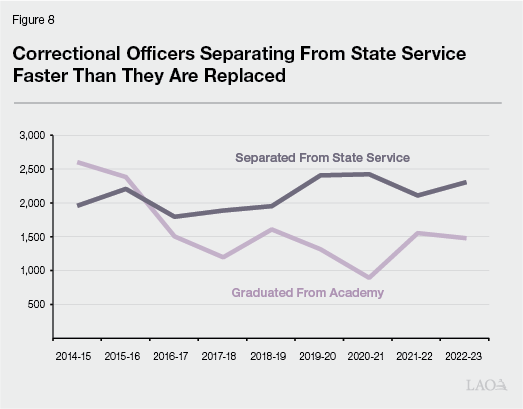
Fewer Vacant Correctional Officer Positions Today Than in
2013. The reduction in the number of state correctional
officers is the result of changes in state policy and does not appear to
be due to challenges in filling established positions. Compared with the
time of the last compensation study, the share of state correctional
officer positions that are vacant has decreased from 14.5 percent in
January 2014 to 12.1 percent in January 2022. On one hand, this suggests
that CDCR is not experiencing greater challenges recruiting and
retaining correctional officers than in 2013. On the other hand, prison
closures have resulted in a substantial reduction in the number of state
positions. With fewer authorized positions, we would expect the vacancy
rate to decrease. The fact that the vacancy rate has only dropped
2 percentage points might signal a recruitment or retention problem,
however, as we discuss below, there are indicators pointing the other
way as well. (Moreover, Unit 6 is unique in that its vacancy rate is
declining, whereas for almost all other bargaining units, the vacancy
rate has increased in recent years.)
Correctional Officer Academy Turns Away More Than
90 Percent of Qualified Applicants. The job of state
correctional officer consistently is a sought-after job. Between 2013‑14
and 2022‑23, CDCR received 372,998 applications to the correctional
officer academy. Of these applications, 292,488 applications were from
applicants who met the minimum qualifications. During this same time
period, the department accepted 17,530 applicants into the academy. This
means that CDCR accepted about 6 percent of qualified
applicants to enroll in the academy to receive training to become a
correctional officer. Among all applications, qualified and not
qualified, CDCR accepted about 5 percent of applicants. (For context,
the academy for the California Highway Patrol accepted 4 percent of
qualified applicants in 2022‑23.) Figure 9 shows how the acceptance rate has fluctuated since 2016-17. There clearly is very high interest
among people to become state correctional officers. The high level of
interest in the job despite its challenging working conditions likely
reflects that, compared with other jobs that have similar education
requirements, the state provides correctional officers competitive
salaries and benefits as well as job security.
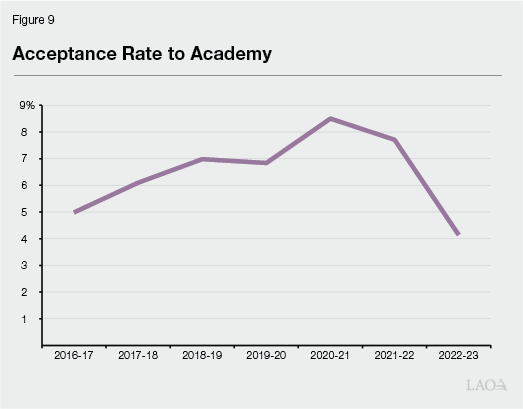
Evidence of Turnover Among Staff. There is
some evidence that there has been elevated turnover among correctional
officers since 2013 where more senior employees are being replaced by
less experienced employees. While the factors that we discuss below show
that the bargaining unit is becoming younger and less experienced, the
average correctional officer continues to be a mid-career correctional
officer with more than a decade of experience. This suggests that the
younger workforce might not be an indication of a problem, but rather
natural turnover as employees retire.
-
Fewer Years of Service Among Staff. The
average Unit 6 member in 2022 had 11.4 years of service. This is about
one year fewer years of service than the average Unit 6 member had in
2012. However, the average Unit 6 member has about one more year of
service than they did in 2008 when the average Unit 6 member had 10.4
years of service. -
Fewer Employees at Top Step. The share
of Unit 6 members who are at the top step of the correctional officer
salary range has decreased from 71 percent in 2013 to 57 percent in
2021. This is consistent with the fact that state correctional officers
tend to have fewer years of service today than they did in
2013. -
Younger Workers. Over the past ten
years, the average Unit 6 member has become younger. The share of Unit 6
members who are 40 years old or younger has increased 10 percentage
points form 42 percent in 2012 to 52 percent in 2022. The fastest
growing age group during this period was 26 to 30 years old.
Any Retention Issues Likely More Attributable to Factors
Other Than Compensation. The turnover of state
correctional officers in recent years likely is due to factors other
than compensation. Figure 10 shows that separations have been driven
primarily by retirements; however, there was a notable increase in the
number of resignations in 2021‑22. When a person resigns, they
voluntarily end their employment without going into retirement. The
person might seek employment with a different employer doing the same
job, change careers, or exit the workforce. If a person is dissatisfied
with their job or with the level of compensation they receive for their
job, they are more likely to resign. As such, a spike in resignations
warrants further investigation to understand the root cause of the
resignations. As we discuss below, we do not think that compensation has
been the main driver leading to increased retirements and a spike in
resignations.
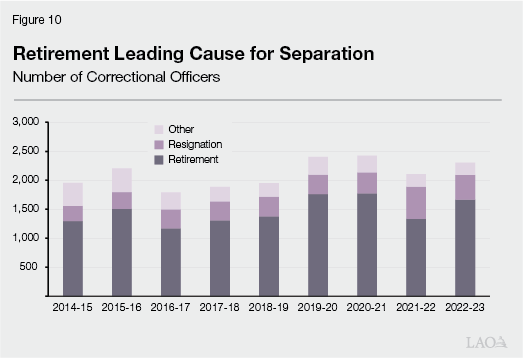
-
Aging Cohort of Correctional Officers Driving
Retirements. The average correctional officer retires at
the age of 55 years after having worked for the state for 23 years—this
statistic is unchanged from 2013. This means that the average retiring
correctional officer was hired at the age of 32 years. In the early and
mid-2000s, the state hired a large number of new correctional officers.
This created a cohort of correctional officers of a similar age. As this
cohort, and the officers hired before this cohort, became eligible for
retirement, they have retired and have been replaced by new, younger
correctional officers. The growth in retirements that CDCR has
experienced in recent years likely is due more to the natural aging of
the workforce rather than a response to Unit 6 compensation
levels.
-
Pandemic. The time period from
March 2020 through September 2022 was a particularly turbulent time for
state prisons. The weekly cases of COVID-19
per 100,000 in state prisons was far above levels seen in California
broadly during each of the waves of the pandemic. The threat to the
health and safety of both people living in prisons and working in
prisons resulted in the administration implementing a number of
personnel policies related to staff testing for the virus, mask wearing,
and vaccination. Both the health risk itself and the administration’s
policies to address the health emergency may have driven the spike in
resignations that occurred in 2021‑22 and could have been a contributing
factor for eligible employees to decide to retire.
Female Correctional Officers
2018 State Law Limits Use of Male Officers at Female
Institutions. In 2018, the Legislature approved and the
Governor signed Chapter 174 (AB 2550,
Weber), adding Section
2644 of the Penal Code. This law seeks to protect females in prison
from sexual assault, abuse, and other improper contact with male
correctional officers. Specifically, the law prohibits—except in
specified emergency situations—male correctional officers from
(1) conducting a pat down search of females in custody, (2) entering an
area inside the prison where females may be in a state of undress, or
(3) being in an area where they can view females in custody in a state
of undress.
Few Female Correctional Officers. The
profession of correctional officer historically has been dominated by
men. Since 2003, the share of Unit 6 members who are women has steadily
declined. Specifically, whereas 21 percent of Unit 6 members were women
in 2003, 17 percent of Unit 6 members were women in 2022. As we said in
2019 when we
reviewed the Unit 6 MOU submitted for ratification that year, CDCR might
need to recruit additional women correctional officers to work in its
women’s prisons to maintain compliance with Section 2644.
2019 MOU Established Working Group to Develop Recruitment
Strategies for Female Staff. The 2019 MOU included
a provision that established a working group to develop strategies to
enhance recruitment, transfer, and retention of female staff at women’s
prisons. We asked CDCR to provide an update to us on the outcome of this
working group. The department informed us that (1) the working group did
not meet and, consequently, did not produce any strategies to improve
recruitment and retention of female staff but (2) the department
independently has implemented strategies. The strategies that CDCR
indicated it has implemented to improve recruitment and retention of
women include targeted marketing; development of a website focused on
women in CDCR; using women recruiters and ambassadors at recruitment
events; recruiting at women-focused events (for example, the Central
Valley Women’s Conference); partnering with women-focused organizations
(for example, women’s athletics programs); and attending national and
state women’s conferences to learn new strategies to attract women
applicants. Lastly, CDCR indicated that it signed onto the 30×30 pledge to
improve the representation of women in police recruits to 30 percent by
2030.
Women Disproportionately Rejected From Academy
Application Process. Part of the challenge of hiring
female correctional officers is due to the fact that more men apply to
become correctional officers than women. For example, since 2011‑12, men
consistently have made up more than 66 percent of the applications
received for the academy with the highest share being in 2011‑12 when
82 percent of the applications were from men. In addition, however,
something in the application screening process results in applications
from women being more likely to be rejected. Specifically, as Figure 11
shows, in all of the past ten years, women have represented a smaller
share of the number of people admitted to the academy than they did the
share of people applying for a position in the academy. As long as this
trend continues, the share of female correctional officers likely will
continue to decline and put at risk CDCR’s compliance with Section 2644.
CDCR indicated that one reason that women have been dropped out of the
application process in the past is because women were more likely to
fail the Physical Fitness Test element of the application process where
applicants are required to carry weights in varying size to specific
distances to simulate carrying a stretcher during an emergency. The
department informs us that, as of March 2023, the Physical Fitness Test
has been removed from the applicant selection process; however, all
cadets will still be required to pass the Physical Fitness Test at the
academy, but can do so in an environment where they can learn and be
mentored in developing the skills needed to pass the course. This could
result in fewer female applicants being rejected from the academy.
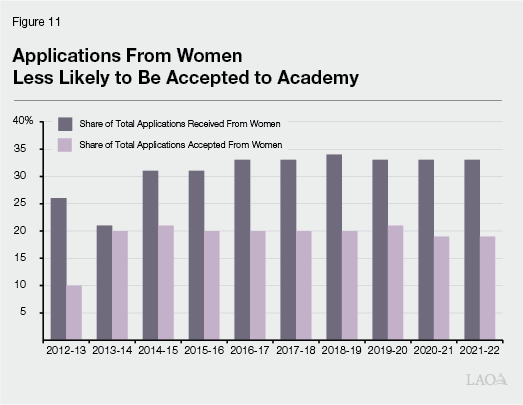
The Proposed Agreement
Changes to
Retirement Benefits Established by PEPRA
Agreement Fundamentally Enhances Unit 6 Retirement
Benefit. The agreement would change the employer-funded
retirement income benefit for Unit 6 members from a defined benefit
pension to a parallel hybrid plan whereby the state funds both a defined
benefit pension and a defined contribution plan. This fundamentally
changes the state’s retirement benefit. Such a change warrants serious
and extensive deliberation to work through issues and questions like
those below.
-
What Problem Is The Proposal Trying to
Address? The defined benefit pension provided to new and
senior Unit 6 members provides a substantial income replacement ratio
that allows the average retiring Unit 6 members to replace nearly 70 of
their income without regard to any personal savings or assets available
to the retiree. A new employee only needs to work four years longer than
more tenured employees to receive the same level of benefit. -
With a New Employer-Funded Defined Contribution
Component, Should the Employer-Funded Defined Benefit Component
Decrease? Hybrid pension plans where employees earn both
an employer-funded defined benefit pension and an employer-funded
defined contribution plan typically include a somewhat less generous
defined benefit than employers who provide only a defined benefit
pension. -
Does Establishing a Hybrid Retirement Plan for Unit 6
Raise Equity or Parity Issues With Other Bargaining Units?
The state’s pension benefit is largely consistent across bargaining
units by providing a defined benefit pension that offers different
income replacement levels depending on date of hire, whether an employee
is in Social Security, and the employee’s job. With an average base pay
of over $95,500, Unit 6 is not a low-income bargaining unit. In
contrast, the average base pay for Unit 15 is about $45,000. As we
indicated earlier, lower-income people typically need a higher income
replacement ratio in retirement as a larger share of their income goes
towards basic needs. -
Should There Be a Vesting Requirement for the State’s
Contribution? Employers generally can establish vesting
requirements that require employees to work for a specified amount
of time before the employee has a right to employer contributions made
to a 401(k). -
With a Larger Share of Unit 6 Utilizing Savings Plus
457(b) Plans, Why Require the Employer Contribution to Go to a
401(k)? Employees must pay Savings Plus maintenance fees
for each account they hold. An employee might want to minimize these
fees by maintaining only one account. With 85 percent of Unit 6 members
participating in a Savings Plus 457(b) plan (compared with 19 percent in
the 401[k] plan), it would make sense to give employees an option to
have the state’s contribution go towards a 457(b) plan.
Location-Specific Bonuses
Administration Gives No Supporting Evidence That Three
Institutions Are “Hard to Fill.” The agreement identifies
SVSP, SAC, and RJD as hard to fill. The administration provides no
evidence or justification to support this claim. Vacancy rates of the
institutions do not support the claims. All three facilities have
lower-than-average vacancy rates of correctional officer positions with
11 percent, 11 percent, and 9 percent vacancy rates, respectively, in
January 2022.
Administration Provides No Justification to Create
Incentive Payments for New Officers to Go to Specified
Institutions. The administration provides no evidence or
justification to suggest that the incentive payments for new officers at
specified facilities are necessary to maintain an inflow of new recruits
to those institutions. The list of institutions includes seven of the
facilities with the most Unit 6 positions (Kern Valley State Prison in
Delano; SVP; San Quentin Rehabilitation Center; Substance Abuse
Treatment Facility and State Prison in Corcoran; California Health Care
Facility in Stockton; RJD; and California State Prison, Corcoran).
However, it is not clear that these institutions are less desirable work
sites for new recruits than other institutions. Vacancy data would seem
to support including Pelican Bay State Prison in Crescent City (with a
28 percent vacancy rate), but several of the other institutions included
on the list have vacancy rates quite a bit lower than the average
vacancy rate for correctional officers across the department
Fiscal Effect
Agreement Will Contribute to Rising Costs to Run
Prisons. As Figure 12 shows, the administration estimates
that the agreement would increase the state’s annual costs by more than
$410 million General Fund. If the provisions of the agreement were
extended to excluded employees affiliated with Unit 6 (generally,
managers and supervisors), the administration estimates that the state’s
annual costs would be nearly $50 million more. This is a significant
effect on the state’s finances. A number of members of the Legislature
regularly express concerns about the rising cost to administer state
prisons. If ratified, relative to the CDCR operational spending assumed
in the budget in 2023‑24, the agreement would increase the cost to run
state prisons by nearly 3 percent.
Figure 12
Administration’s Estimated Fiscal Effect of Proposed Unit 6 Agreement
(In Millions)
|
2023-24
|
2024-25
|
||||
|
General Fund
|
All Funds
|
General Fund
|
All Funds
|
||
|
General Salary Increases
|
$127.4
|
$127.4
|
$258.5
|
$258.5
|
|
|
Health Benefits
|
16.9
|
16.9
|
45.4
|
45.4
|
|
|
Pay Differentials
|
27.9
|
27.9
|
37.2
|
37.2
|
|
|
One-Time $1,200 Payments
|
29.5
|
29.5
|
29.5
|
29.5
|
|
|
Employer Contributions to 401(k)
|
—
|
—
|
22.9
|
22.9
|
|
|
Recruitment and Retention Payments
|
3.3
|
3.3
|
16.3
|
16.3
|
|
|
Other Provisionsa
|
1.3
|
1.3
|
2.0
|
2.0
|
|
|
One-Time Leave Cash Out
|
25.2
|
25.2
|
—
|
—
|
|
|
Totals
|
$231.5
|
$231.5
|
$411.8
|
$411.8
|
|
Legislature’s Role in
Bargaining Process
Legislature Is Ultimate Authority of Any Labor
Agreement. Under the Ralph C. Dills Act, while the
Governor negotiates terms and conditions of employment with bargaining
units, the Legislature retains the ultimate authority to approve or
reject agreements. The Legislature can reject an agreement either by
(1) rejecting a tentative agreement that is submitted to the Legislature
for ratification or (2) not appropriating sufficient funds to pay for
the terms of an MOU that the Legislature has already ratified.
Administration’s Delivery of Agreement Does Not Allow for
Sufficient Time for Legislative or Public Review. The
administration submitted this agreement to the Legislature three days
before the budget committees heard the agreement. Giving the Legislature
such a constrained review period to review a proposal with such
significant fiscal and policy implications is inappropriate. The
public—including the members of the bargaining unit—also should have a
greater opportunity to review the provisions of the agreement and
provide input to the Legislature.
Budget Change Proposals of Far Smaller Size Would Require
Justification From Administration, Legislative Deliberation, and Public
Scrutiny. If ratified, the agreement will increase state
costs by hundreds of millions of dollars each year. When budget
proposals of far lesser value are submitted to the Legislature by the
Governor during the budget process, they are subject to public and
legislative review for a period of weeks or months, not days.
LAO Recommendations
Review How to Improve Access to Collective Bargaining
Information. In order to improve legislative oversight of
the state’s employee compensation policies, we recommend that the
Legislature review how it can gain better access to information
discussed through the collective bargaining process. In particular, when
future agreements establish JLMC processes, we recommend that the
Legislature seek clarification as to (1) what information the parties
will share with the Legislature and (2) when such information might be
shared with the Legislature.
Establish Consistent Requirements for Compensation
Studies of All Bargaining Units. While the compensation
study that CalHR produces for other bargaining units is not perfect, it
is helpful for understanding how the state’s total compensation compares
with that provided by other employers to similar employees across
California. In contrast, compensation studies that look at only a small
handful of select and unrepresentative samples—like Unit 6 as well as
the annual salary survey of Unit 5—are not helpful in understanding
whether the state’s compensation policies are competitive. While there
can be separate unit-specific salary surveys or other compensation
studies, we recommend that the state’s regular total compensation report
established in Section 19826 of the Government Code use a consistent
methodology that allows for the Legislature to have better oversight of
the workforce and the state’s compensation policies.
Consider Utilizing Third Party to Conduct Compensation
Studies on Scheduled Basis Independent of Bargaining
Cycle. We recommend that the Legislature consider removing
from CalHR the responsibility of conducting the state’s regular total
compensation studies and, instead, consider directing CalHR to contract
out this responsibility to a third party that is independent from the
collective bargaining process. For example, the state could contract
with the University of California, like Unit 2 did in the past, to
conduct the review.
Require Bargaining Cycle to Consider Legislative
Calendar. The parties regularly submit labor agreements to
the Legislature with a legislative deadline looming only days away. This
is a long-standing problem and is not unique to this administration. In
the case of this agreement, the parties reached agreement a week before
the administration transmitted any documents to the Legislature—only
days before the scheduled August 30 budget hearings. This time
constraint is unnecessary. The legislative calendar is public and known
far in advance. The legislative calendar and deadlines should be built
into the administration’s planning such that the Legislature has
sufficient time to consider labor agreements. As we have recommended in
the past, we recommend that the Legislature adopt a standing policy to
reject (1) any agreement that affects the compensation of state
employees in the July pay period that is submitted to the Legislature
after June 2 and (2) any agreement that is submitted to the Legislature
fewer than two weeks before the end of session.




